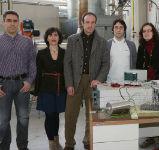 Spain. Researchers from the Public University of Navarra are working on the development of cooling systems that are capable of producing cooling without electricity consumption. Specifically, they have already created a prototype of a thermoelectric self-cooling device that achieves a "free" cooling of more than 30ºC in devices that emit heat.
Spain. Researchers from the Public University of Navarra are working on the development of cooling systems that are capable of producing cooling without electricity consumption. Specifically, they have already created a prototype of a thermoelectric self-cooling device that achieves a "free" cooling of more than 30ºC in devices that emit heat.
It is an equipment that acts like a traditional refrigerator, but does not consume electricity, since it obtains the necessary energy to operate from the heat itself that must be dissipated. The researchers want to apply this system to power converters and transformers, present in renewable electricity production plants, such as wind, solar photovoltaic, solar thermoelectric and hydraulic energy.
David Astrain Ulibarrena, from the Department of Engineering, Mechanics, Energy and Materials of the UPNA and principal investigator of the project, explains what the system consists of: "These devices, when they work, are heated and have to be cooled. In many cases heat exchangers are used with fans that, logically, must be externally powered and consume a certain amount of electrical power. What we do is take advantage of the heat flow emitted by the power converter and the transformer to produce the electrical energy necessary to run the fans. Thus, we achieve cooling and control the temperature of the device, but without energy cost."
This application of thermoelectric self-cooling is one of the lines of action of the Geter project (Thermoelectric generation with residual heat energy), whose general objective is to develop thermoelectric generators that allow converting low thermal heat energy into electrical energy; that is, waste heat flows of temperatures below 250º C.
Within the framework of this project, the research group has developed and experimentally validated a computational model that has shown the possibility of obtaining up to 1 kW of electrical energy for each cubic meter of an industrial chimney.
The Geter project has a funding of 86,000 euros from the National Plan of aid to non-oriented fundamental research projects and has a duration of three years.
With information from the Public University of Navarra.













